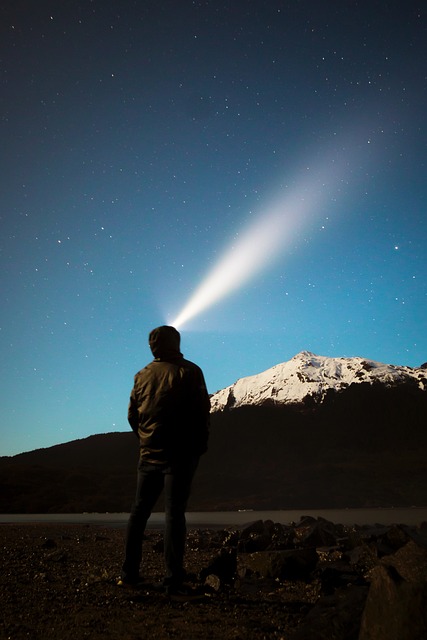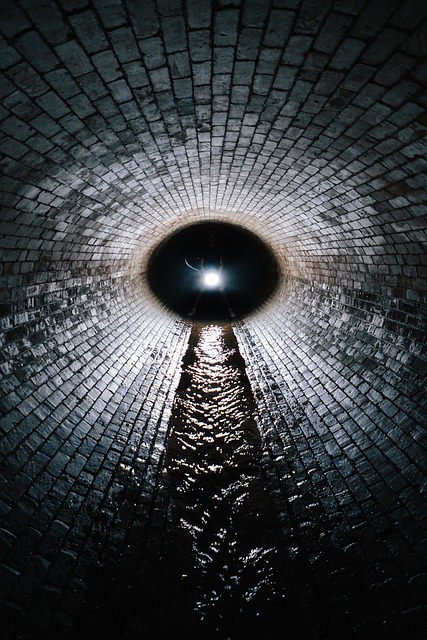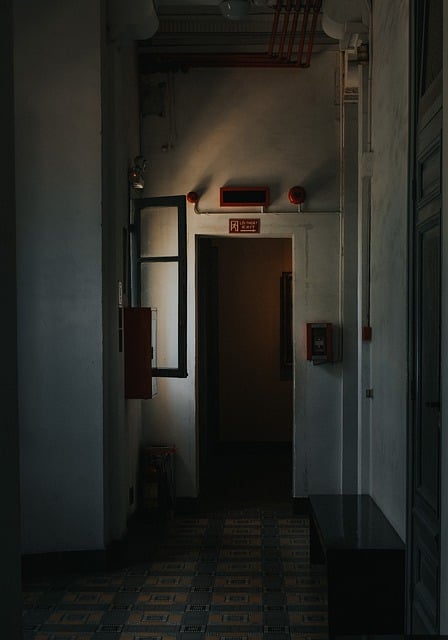Flashlights are indispensable for emergency preparedness, providing consistent illumination during power outages or other emergencies. They range from traditional batteries to advanced LED models with various settings suitable for different scenarios. It's crucial to assess your home's vulnerabilities, identify which areas require immediate lighting, and select appropriate flashlights based on the typical duration of power outages in your area. A diverse set of flashlights with different light intensities and beam focuses can handle a range of tasks, from reading to surveying large areas. Regular maintenance, including battery checks and replacements, and familiarization among household members ensure these tools are ready when needed. For sustained functionality, consider rechargeable battery packs, crank-powered, or solar-rechargeable options, as well as waterproof and shock-resistant models for durability in harsh conditions. Training in flashlight usage through drills helps reduce panic and enhance efficiency during unexpected darkness scenarios. High-quality flashlights tailored for emergencies should be part of a comprehensive emergency plan, offering immediate and sustained illumination when conventional lighting sources fail. Routine maintenance, including cleaning, inspecting for wear and tear, and managing batteries properly, is vital to ensure flashlights remain reliable tools in handling darkness emergencies effectively.
In the event of unexpected darkness emergencies, be it power outages or other disruptions, the reliability of flashlights for emergency preparedness becomes paramount. This article delves into the critical aspects of safeguarding your home and family against sudden loss of light. From evaluating your residence’s susceptibility to extended darkness to amassing a tailored selection of flashlights suitable for diverse scenarios, we explore essential strategies. Additionally, we emphasize the importance of regular maintenance and battery management to ensure that your flashlights are always ready when needed. By following the guidance in this article on training and drills for effective flashlight usage during emergencies, you can enhance your preparedness significantly.
- Understanding the Importance of Flashlights in Emergency Preparedness
- Assessing Your Home's Vulnerabilities to Unexpected Darkness
- Building a Comprehensive Flashlight Inventory for Different Scenarios
- Training and Drills for Effective Use of Flashlights During an Emergency
- Maintenance and Battery Management for Long-Term Reliability of Flashlights
Understanding the Importance of Flashlights in Emergency Preparedness

In the event of an unexpected power outage or a sudden emergency, flashlights for emergency preparedness become indispensable tools. They provide a reliable source of illumination when conventional lighting sources fail, which is why they are critical components of any comprehensive disaster kit. The dependability of flashlights cannot be overstated; they operate without the need for electrical grid connectivity and can often be the only light available in the immediate aftermath of a disaster. Their portability means that they can be taken with you as you navigate through darkened spaces, reducing the risk of injury from tripping or falling. Additionally, flashlights can be directed to illuminate specific areas, which is particularly useful when trying to maintain situational awareness or perform tasks in low-light conditions. For these reasons, having a durable and high-quality flashlight readily accessible is an essential aspect of being prepared for unexpected darkness emergencies.
Moreover, the versatility of modern flashlights enhances their importance in emergency situations. They come with various light modes, including high, medium, and low settings, as well as strobe or SOS functions that can be used for signaling for help. Some models are also equipped with rechargeable batteries or long-lasting alkaline batteries, ensuring they are ready when needed. The best flashlights for emergency preparedness are those that have been tested for durability and reliability, offering a consistent light output even under the most challenging conditions. Whether it’s a home power outage or an outdoor adventure where sudden darkness may occur, having a reliable flashlight is a prudent step in ensuring personal safety and the ability to effectively manage through unforeseen situations.
Assessing Your Home's Vulnerabilities to Unexpected Darkness

In the event of an unexpected darkness emergency, having a well-prepared home is crucial for navigating safely through prolonged periods of power outages. Assessing your home’s vulnerabilities begins with understanding the types of flashlights available for emergency preparedness and their suitability for different situations. Flashlights for emergency preparedness come in various forms, from traditional battery-powered models to high-tech LED options with multiple settings that can illuminate both close and distant areas. Evaluate where such outages are most likely to occur—be it a specific room or throughout the entire house—and consider which areas require immediate visibility. For instance, if you frequently experience power outages during storms in your fuse box, prioritize securing flashlights for emergencies in areas that are critical for navigation and safety, such as hallways, staircases, and the path to your emergency kit.
Furthermore, consider the duration of typical power outages in your area. This will influence the type and quantity of batteries you should store—rechargeable or disposable—as well as the number of flashlights for emergency preparedness you’ll need. It’s also wise to have a selection of flashlights with different light intensities and beam focuses to address various tasks, from reading fine print to scanning large areas. Regularly testing your flashlights and replacing batteries according to manufacturer guidelines ensures that when darkness descends unexpectedly, you and your family are not left in the dark. Additionally, ensure that every member of your household knows where the emergency flashlights are located and how to operate them, fostering a sense of preparedness and reducing panic during such events.
Building a Comprehensive Flashlight Inventory for Different Scenarios

When crafting a comprehensive flashlight inventory for unexpected darkness emergencies, it’s crucial to consider the variety of scenarios one might face. Flashlights for emergency preparedness should cater to different levels of brightness, power sources, and environmental conditions. A solid inventory includes a mix of compact, ultra-bright models that serve as instant, all-purpose lighting solutions during a blackout or sudden darkness event. These high-lumen flashlights are invaluable for tasks that require clear visibility, such as navigating through a darkened home or assessing the extent of an outage. Additionally, incorporating flashlights with specialized settings, like red or green light modes, can preserve night vision and reduce the potential for glare, which is particularly beneficial when you need to maintain stealth or avoid startling animals or people.
For longer-term power outages or unforeseen situations where traditional batteries may deplete, having flashlights with rechargeable battery packs or crank-powered options ensures prolonged usability. Solar-rechargeable flashlights are also a sustainable addition to your emergency kit, harnessing natural light to maintain readiness. It’s equally important to include waterproof and shock-resistant models in your inventory, as they can endure the elements and rough handling during chaotic or physically demanding scenarios. Each flashlight should be stored with fresh batteries and kept in an easily accessible location, ready to provide dependable illumination whenever darkness strikes unexpectedly.
Training and Drills for Effective Use of Flashlights During an Emergency

In the event of an unexpected darkness emergency, such as a power outage or natural disaster, the effectiveness of one’s flashlights can be the difference between safety and disorientation. To ensure preparedness, individuals and organizations should invest in high-quality flashlights specifically designed for emergency situations. Training in their use is equally critical. Regular drills that simulate various darkness scenarios can familiarize users with the handling and operation of these devices under pressure. Practicing in a controlled environment helps to mitigate panic during real emergencies, allowing for swift and efficient use of light sources. These drills should cover basic operations like turning the flashlight on and off, changing batteries, and directing the beam where needed. Additionally, it’s important to practice using the flashlight with one hand if necessary, as darkness situations can impede mobility or limit free hands. By integrating flashlights for emergency preparedness into routine drills, individuals and communities can enhance their response capabilities, ensuring a more resilient approach to unexpected darkness events.
Furthermore, the concept of ‘muscle memory’ plays a significant role in effective flashlight usage. Regular practice with flashlights, including handling them in low-light conditions, can help users become proficient without the need for conscious thought during an emergency. This proficiency extends to knowing where to direct the light—whether it’s to navigate through an unfamiliar environment or to signal for help. The integration of flashlights into emergency preparedness kits and the inclusion of flashlight training in broader safety education programs are steps that can significantly improve individual and collective responses to darkness emergencies. By prioritizing these practices, individuals can be better equipped to handle the challenges that arise when the lights go out unexpectedly.
Maintenance and Battery Management for Long-Term Reliability of Flashlights

When it comes to emergency preparedness, flashlights are indispensable tools for navigating unexpected darkness. For long-term reliability, regular maintenance is paramount. Users should routinely inspect their flashlights for any signs of wear or damage, ensuring the lens and reflector are clean and free from scratches that could impair light output. The battery compartment requires special attention; it’s essential to replace batteries before they lose significant capacity. Alkaline batteries typically perform well, but rechargeable options can be more cost-effective and environmentally friendly with proper care. Regardless of the battery type, storing flashlights in a cool, dry place prevents corrosion and prolongs battery life. Flashlights for emergency preparedness should come with clear instructions on how to maintain them, including guidance on the correct handling and storage of their batteries.
Battery management is integral to maintaining the functionality of your flashlight during an emergency. To ensure peak performance, it’s advisable to keep spare batteries on hand, as well as a battery charger that’s compatible with your flashlight model. Understanding the voltage and type of battery required by your flashlight prevents the misuse of incompatible batteries, which could damage the device. Additionally, many high-quality flashlights for emergency preparedness come equipped with low-battery indicators or automatic shutoff features to alert users when it’s time to replace the power source. By adhering to these maintenance practices and being proactive about battery management, your flashlight will serve as a dependable source of light whenever darkness strikes unexpectedly.
In conclusion, maintaining a robust set of flashlights for emergency preparedness is not just a precaution—it’s an indispensable strategy for ensuring safety and resilience during unexpected darkness emergencies. By understanding the critical role flashlights play, assessing your home’s potential vulnerabilities to sudden power outages, and assembling a varied inventory of high-quality flashlights suited for diverse situations, you lay the foundation for effective emergency response. Regular training and drills further hone your proficiency in employing these tools when needed. Equally important is the commitment to maintaining your flashlight arsenal through diligent battery management and routine checks to guarantee they are operational when darkness falls unexpectedly. Embrace the practice of flashlights for emergency preparedness, and you’ll be better equipped to navigate the unpredictability of power interruptions with confidence and clarity.
